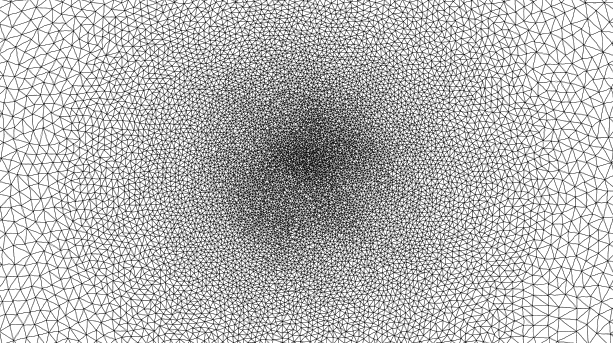Famous Fluid Equations Are Incomplete
In 1900, the great mathematician David Hilbert presented a list of 23 unsolved problems worth investigating in the new century. The list became a road map for the field, guiding mathematicians through unexplored regions of the mathematical universe as they ticked off problems one by one. But one of the problems was not like the others. It required connecting the mathematical universe to the real one.
Hilbert’s sixth problem called upon researchers to axiomatize the laws of physics — that is, rigorously construct them from a basic set of starting assumptions, or axioms. Doing so would reveal contradictions between laws that demanded different axioms. And deriving the entire body of physical laws from the same axioms would prove they were not merely haphazard, incoherent descriptions of disparate phenomena, but instead formed a unified, mathematically airtight, internally consistent theory of reality. “Once again it was an issue of unification, which pervades physics to this day,” said Marshall Slemrod, a mathematician at the University of Wisconsin, Madison.
Axiomatizing all of physics was a tall order, so Hilbert proposed a specific task: Determine whether the microscopic and macroscopic pictures of a gas rest on equivalent axiomatic foundations, and are thus different manifestations of a single theory. Experts approached this problem by attempting to mathematically translate the Boltzmann equation, which describes a gas as microscopic particles bouncing around at a range of speeds, into the Navier-Stokes equations, which describe the gas on larger scales as a continuous, flowing entity. Could the particle and fluid pictures be rigorously linked?
While Hilbert’s broader aim of axiomatizing physics remains unfulfilled, recent research has yielded an unexpected answer to the particle-fluid question. The Boltzmann equation does not translate into the Navier-Stokes equations in all cases, because the Navier-Stokes equations — despite being exceptionally useful for modeling the weather, ocean currents, pipes, cars, airplane wings and other hydrodynamic systems, and despite the million-dollar prize offered for their exact solutions — are incomplete. The evidence suggests that truer equations of fluid dynamics can be found in a little-known, relatively unheralded theory developed by the Dutch mathematician and physicist Diederik Korteweg in the early 1900s. And yet, for some gases, even the Korteweg equations fall short, and there is no fluid picture at all.
“Navier-Stokes makes very good predictions for the air in the room,” said Slemrod, who presented the evidence last month in the journal Mathematical Modelling of Natural Phenomena. But at high altitudes, and in other near-vacuum situations, “the equations become less and less accurate.”
Remarkably, this surprising conclusion could have been reached long ago, before Hilbert ever posed the sixth problem. In 1879, another titan of science, the Scottish physicist James Clerk Maxwell, pointed out that the Navier-Stokes equations fail to explain a near-vacuum experiment called the Crookes radiometer — apparently unbeknownst to Hilbert. “It would have been nice if he read Maxwell,” Slemrod observed.
Many mathematicians worked hard on the particle-fluid question after 1900, including Hilbert himself. He began by rewriting the complicated Boltzmann equation as the sum of a series of decreasing terms. Theoretically, this chunky decomposition of the equation would be more easily recognizable as a different, but axiomatically equivalent, physical description of a gas — perhaps, a fluid description. The terms in the series quickly become unruly, however; energy, instead of diminishing at shorter and shorter distances in the gas, seems to amplify. This prevented Hilbert and others from summing up the series and interpreting it. Nonetheless, there was reason for optimism: The leading terms of the series looked like the Navier-Stokes equations when a gas becomes denser and more fluidlike. “So the physicists were happy, sort of,” said Ilya Karlin, a physicist at ETH Zurich in Switzerland. “It’s in all the textbooks.”
But did the Boltzmann equation, which the Austrian physicist Ludwig Boltzmann derived in 1872, actually converge to the Navier-Stokes equations, developed decades earlier by Claude-Louis Navier of France and George Stokes of Ireland and England, or to something else? The question remained open. In the early 1990s, Karlin, then a student working with Alexander Gorban in Krasnoyarsk, Siberia, took another crack at the series that had foiled Hilbert. The location proved helpful. “We always joked that … it’s the edge of the civilized world, so you sit there and think of great problems.”
Karlin and Gorban developed a simplified model of the Boltzmann equation that contained the essential difficulties of the original, and expanded the model equation in a series. Then, using a few mathematical tricks, they managed to sum it up exactly. The solution was not what they had expected. The problematic amplifying parts of the series were bundled together as an extra term in the solution. When, years later, Slemrod came across the Russian scientists’ work, he recognized the term’s significance. “Marshall noticed that the structure of the exact equations that come out of my solution is not Navier-Stokes,” Karlin said, “but something very much reminding us [of] the equations of Korteweg, for the two-phase fluid.”
Korteweg modeled the dynamics of fluids in which there is not only dissipation of energy (which is characterized by the Navier-Stokes equations), but also dispersion, or the smearing of energy into its component frequencies, as in a rainbow. Dissipation results from a fluid’s viscosity, or internal friction. But dispersion is caused by its capillarity — the surface tension effect that makes some liquids rise in straws. In most fluids, capillarity is negligible compared to viscosity. But it isn’t always. And mathematically, it never is. It was this capillarity, Slemrod argued in a 2012 paper, that appeared as the extra term in Karlin and Gorban’s solution to their Boltzmann-like equation. Although the finding has not yet been generalized to the full Boltzmann equation, it indicates that the particle description of a gas, when translated into a fluid description, converges not to the Navier-Stokes equations, but to the more general, far less famous Korteweg equations.
Slemrod “gives very solid arguments that Korteweg hydrodynamics has a much wider area of applicability than Navier-Stokes,” said Gorban, who is now a professor of applied mathematics at the University of Leicester in England. Still, Gorban notes, his work with Karlin suggests that some gases of particles cannot even be captured by the Korteweg equations. When short-distance interactions between particles become strong enough, he said, such as at the edge of a shock wave, even capillarity cannot fully account for their behavior, and “there exist no hydrodynamics.”
The incompleteness of the Navier-Stokes equations becomes apparent in an old experiment that is often for sale in museum gift shops. The Crookes radiometer, a windmill housed inside a partial vacuum chamber made of glass, rotates when exposed to light. In 1879, Maxwell attempted to describe the turning vanes of the Crookes radiometer by modeling the thin air inside the vacuum chamber as a fluid. Maxwell determined that if the equations “given by Professor Stokes,” as he called them, told the full story of the fluid, the vanes would not turn. The turning of the vanes can, however, be modeled as a capillarity effect, and described by the Korteweg equations.
To “mathematicians who have never been in a laboratory in their life, I finally get their attention and say, ‘Look at this thing!” said Slemrod, referring to the Crookes radiometer. “There are real things happening here, and you can learn from them!’”
Slemrod hopes that employing the Korteweg equations rather than Navier-Stokes will be useful for modeling near-vacuum gases, like the thin air surrounding orbiting satellites. “My hope is that it might be possible to use this corrected version down near the vacuum instead of the Boltzmann equation, [which] is a nasty object to solve,” he said.
Leo Corry, a historian of mathematics at Tel Aviv University in Israel who has written a book about David Hilbert and his sixth problem, notes that Hilbert’s original aim seems to have gotten lost in the details of the particle-fluid question and remains unaddressed. “Notice that the words ‘axiom’ or even ‘foundation’ or ‘conceptual analysis’ do not appear even once in Slemrod’s review,” Corry said.
If anything, Hilbert’s goal of axiomatizing physics grew more daunting as the 20th century progressed. Even more challenging than the complicated relationship between particle and fluid dynamics is the seemingly irreconcilable conflict between quantum mechanics and general relativity — descriptions of nature at still smaller and larger scales.
But even if the particle-fluid question isn’t a perfect proxy for the sixth problem, it has taken on a life of its own. “I would not even dare to say that it is less important than what Hilbert had in mind when putting forward his sixth problem,” Corry said. “I would not argue with anyone saying that, indeed, it is much more important and impressive.”
Editor’s Note: Marshall Slemrod receives funding from the Simons Foundation as a 2012 Collaboration Grant awardee.
This article was reprinted on Wired.com.




